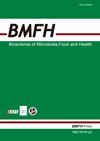局部游离脂肪酸触发小鼠白色脂肪组织中脂多糖结合蛋白的表达
IF 2.9
4区 医学
Q2 Agricultural and Biological Sciences
引用次数: 2
摘要
虽然脂多糖(LPS)结合蛋白(LBP)是一种主要由肝细胞产生的急性期蛋白,但它也被认为是一种促炎脂肪因子。据报道,肥胖和高脂肪饮食(HFD)的消耗与血浆中脂多糖(LPS)和白色脂肪组织(WAT)中游离脂肪酸(FFAs)水平升高有关。我们检查了循环LPS或局部FFAs是否对hfd诱导的WAT中LBP的增加负责。雄性C57BL/6J小鼠分别饲喂正常脂肪饮食(NFD)和高脂肪饮食(HFD)。测定肝脏和肠系膜WAT (mWAT) mRNA水平、mWAT中总游离脂肪酸含量以及血浆中LBP和LPS浓度。在3、7、28天或14周内,饲喂高脂肪食物的小鼠在mWAT中的Lbp mRNA水平高于饲喂低脂肪食物的小鼠,而肝脏Lbp mRNA水平在两组之间没有差异。在没有肠道微生物群(LPS的来源)的无菌小鼠中,HFD也增加了mWAT中Lbp mRNA的水平。血浆LPS水平与mWAT Lbp mRNA水平无显著相关性。饲喂高脂肪食物的小鼠mWAT中总游离脂肪酸含量高于饲喂低脂肪食物的小鼠,且与Lbp mRNA水平呈正相关。添加棕榈酸可提高3T3-L1脂肪细胞中Lbp mRNA水平。我们提出,局部FFAs,而不是循环LPS,是HFD喂养小鼠mWAT中Lbp表达增加的触发因素。本文章由计算机程序翻译,如有差异,请以英文原文为准。
Local free fatty acids trigger the expression of lipopolysaccharide-binding protein in murine white adipose tissue
Although lipopolysaccharide (LPS)-binding protein (LBP) is an acute-phase protein mainly produced by hepatocytes, it has also been proposed to be a pro-inflammatory adipokine. Obesity and the consumption of a high-fat diet (HFD) are reportedly associated with elevated levels of LPS in plasma and free fatty acids (FFAs) in white adipose tissue (WAT). We examined whether circulating LPS or local FFAs are responsible for the HFD-induced increase of LBP in WAT. Male C57BL/6J mice were fed either a normal-fat diet (NFD) or an HFD. The mRNA levels in the liver and mesenteric WAT (mWAT), total FFA content in mWAT, and LBP and LPS concentrations in plasma were determined. The Lbp mRNA level in mWAT was higher in mice fed the HFD than in those fed the NFD for 3, 7, or 28 days or 14 weeks, whereas the hepatic Lbp mRNA level did not differ between the groups. The Lbp mRNA level in mWAT was also increased by the HFD in germ-free mice, which do not have gut microbiota, the source of LPS. The plasma LPS level did not show a significant correlation with the mWAT Lbp mRNA level. The total FFA content in mWAT was higher in mice fed the HFD than in those fed the NFD and positively correlated with the Lbp mRNA level. Supplementation with palmitic acid increased the Lbp mRNA level in 3T3-L1 adipocytes. We propose that local FFAs, but not circulating LPS, are the trigger for increased Lbp expression in mWAT of mice fed the HFD.
求助全文
通过发布文献求助,成功后即可免费获取论文全文。
去求助
来源期刊

Bioscience of Microbiota, Food and Health
Immunology and Microbiology-Applied Microbiology and Biotechnology
CiteScore
5.50
自引率
3.20%
发文量
24
期刊介绍:
Bioscience of Microbiota, Food and Health (BMFH) is a peer-reviewed scientific journal with a specific area of focus: intestinal microbiota of human and animals, lactic acid bacteria (LAB) and food immunology and food function. BMFH contains Full papers, Notes, Reviews and Letters to the editor in all areas dealing with intestinal microbiota, LAB and food immunology and food function. BMFH takes a multidisciplinary approach and focuses on a broad spectrum of issues.
 求助内容:
求助内容: 应助结果提醒方式:
应助结果提醒方式:


